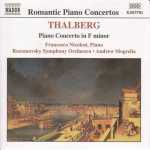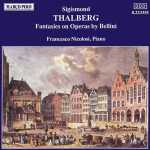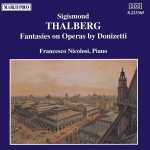
Performer: Francesco Nicolosi
Composer: Sigismund Thalberg
Audio CD
SPARS Code: DDD
Number of Discs: 1
Format: APE (image+cue)
Label: Naxos
Size: 222 MB
Recovery: +3%
Scan: yes
# Grand fantaisia and variations on themes from “Norma,” for piano, Op. 12
Composed by Sigismond Thalberg
with Francesco Nicolosi
# Grand fantaisie et Variations Sur des Motifs de I Capuletti, for piano, Op. 10
Composed by Sigismond Thalberg
with Francesco Nicolosi
# Fantaisia on themes from “Beatrice di Tenda,” for piano, Op. 49
Composed by Sigismond Thalberg
with Francesco Nicolosi
# Fantaisia on themes from “La Straniera,” for piano, Op. 9
Composed by Sigismond Thalberg
with Francesco Nicolosi
# Grande caprice on La Sonnambula, for piano, Op. 46
Composed by Sigismond Thalberg
with Francesco Nicolosi
“More perfect as a real virtuoso”
Sigismond Thalberg’s name in today’s view of music history is almost exclusively linked with the great pianistic rivalry he shared with Franz Liszt. But Thalberg’s life, influence on the composers around him, and the popularity of his music during his lifetime reveals that he had a far more substantial role in music history. Thalberg’s peculiar mannerism of sitting at the piano with a firm and motionless composure while playing heavily demanding virtuosic passages led Mendelssohn to believe that Thalberg, “within his more restricted sphere, is more perfect as a real virtuoso.” Thalberg’s style of performance, however, seems totally incongruous with his own compositions, especially his operatic fantasias, which effuse not only brilliant pianistic effects, but also emotionally expressive music. Apparently, Thalberg studied singing for five years, and it shows in the vocal qualities of his own piano-writing. This Naxos release is a reissue from the Marco Polo label, and I feel it deserves five stars for the special first-recorded content and the excellent interpretations given. The performances by the stupendous Francesco Nicolosi, the president of the Thalberg International Study Center, are marvelous and without defects.
Thalberg’s Grande Fantaisie on Bellini’s Norma Op. 12 is an exceptional work, and Robert Schumann gave it a positive review in his New Journal of Music. Being familiar with Liszt’s Norma Fantasy, I found a lot in common between the two. But while Liszt’s dramatic mood far exceeds Thalberg’s, the virtuosic thrill and beautiful thematic material makes Thalberg’s Fantasy as equally memorable as Liszt’s. In his insightful book, From Paris to Peoria: How European Piano Virtuosos Brought Classical Music to the American Heartland, R. Allen Lott observes that in Thalberg’s fantasia writing “Instead of merely assembling a string of mechanical variations, Thalberg [molds] the work into a dramatic unity, gradually building toward a grand climax through various restatements of the unchanging theme while the accompaniment [shifts] kaleidoscopically.” I concur, especially after relistening to the two Fantaisies on Bellini’s I Capuletti and Beatrice di Tenda. These majestic fantasies exude enough emotional ideas from their inherent operatic themes, but Thalberg’s cantabile writing and electrifying embellishments somehow enhances the sensationalism of the music.
R. Allen Lott also believes “Thalberg’s emphasis on a singing tone and brilliant virtuosic display [coalesces] in his opera fantasias, in which a lyrical melody from an operatic source is surrounded by the most severe technical demands.” The Fantaisie on Bellini’s La Straniera is a perfect example. Thalberg’s innate sense of vocality and aria-like melodic line comes across in his pianistic treatment. Needless to say, Thalberg also works in dazzling embellishments and virtuosic fanfares. It is with the Grande caprice on Bellini’s La Sonnambula that I am most taken with, though. The Introduction is full of incredible angst and orchestral sonorities and the subsequent themes from Bellini’s opera gush with beauty. Thalberg uses all of his tricks of textured trills, sequenced chords, trickling arpeggios and other decorations. Yet somehow the emotional strength of Bellini’s themes is never compromised. With typical Romantic bravura, the piece climaxes with fortissimo restatements and whirling energetic ornamentations. The whole fantasy is a lovely tour-de-force and a strong case for Thalberg’s compositions.
Bottom line: The American critic John Sullivan Dwight didn’t think there was much profundity in Thalberg’s music but made the point that these fantasies “illustrate the possibilities of the piano, in a way to strike and astonish, but above all to please the general ear of music lovers.” I think Thalberg’s music deserves more credit than this and I believe Francesco Nicolosi proves there is more to this music than mere pianistic display. Nicolosi’s robust virtuosity enables him to focus on interpretation, and I think his performances shed new light on Thalberg.




Great Music!!! Thank you!
Magnificent!!!……Thank You Very Much